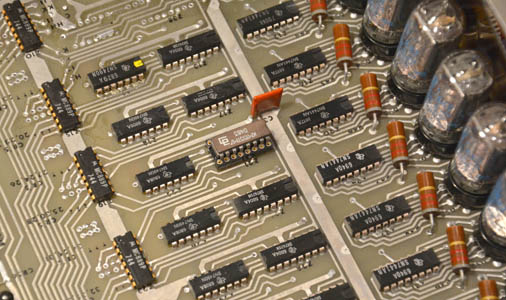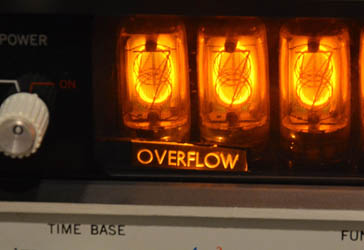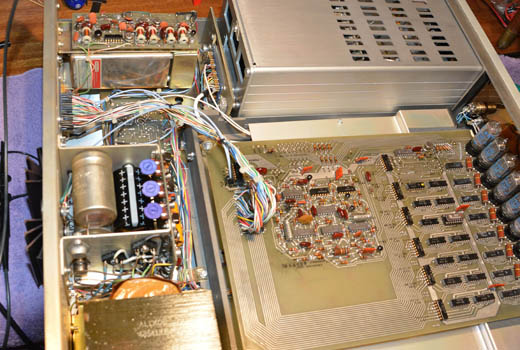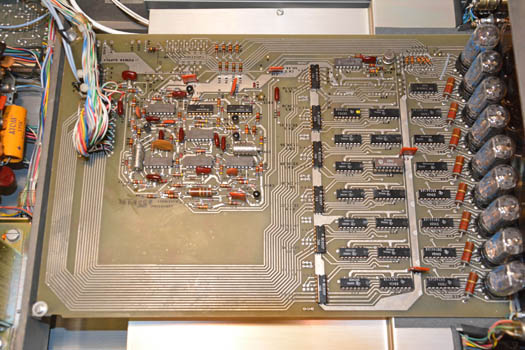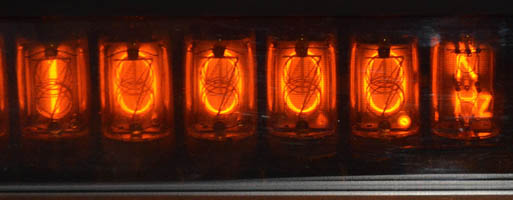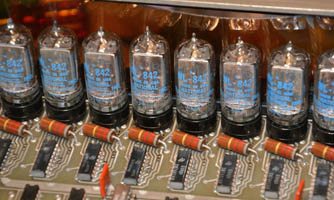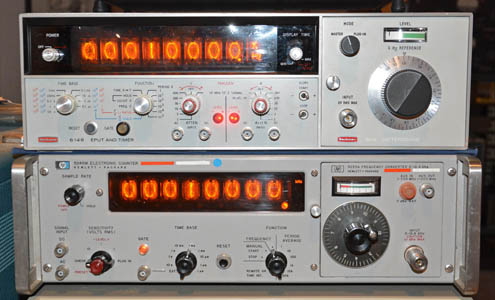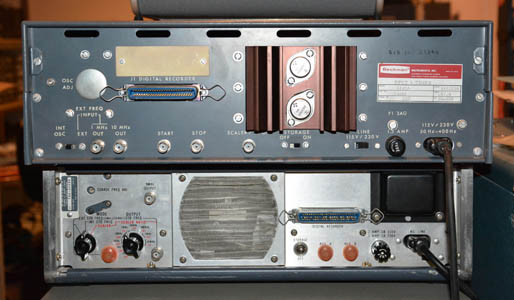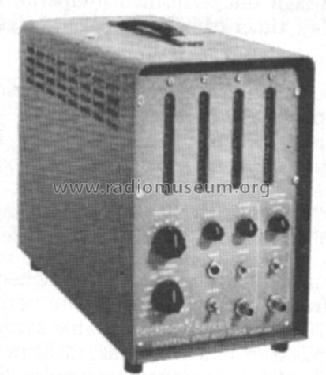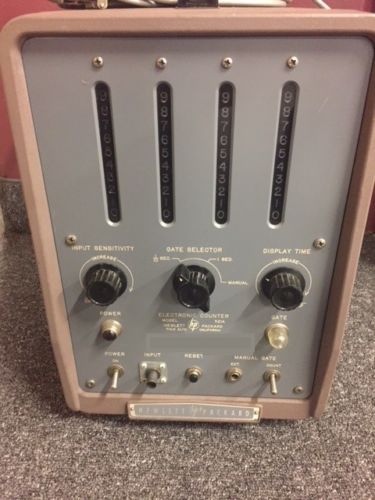Beckman 6148AEPUT and TimerHere is a beautiful and rare Beckman EPUT meter and Timer made in 1970, which I repaired in the summer of 2018. "EPUT" stands for "Events Per Unit Time", Beckman's way of saying frequency, so in today's terms, this is a frequency counter and timer. Unlike the Hewlett Packard counters of around the same time, which used discrete parts, this instrument makes use of many integrated circuits. These are mainly standard 7400 series TTL chips, as well as now-obscure Motorola DTL chips such as MC849P and MC861P. These chips, along with a more awkward design (especially the gigantic counter/display board with hard-wired connections) make it a more difficult unit to service than HP counters, though it's still undoubtedly more serviceable than modern counters will be in 50 years! The 6148A appears to be an extremely rare unit; I could not find a single reference to it online, not even for sale. I did find a page on the 6155, which looks very similar except without the "Y" input's controls (though the input is still there, and the functions all appear to be the same). My 6148A has serial number 283, which also suggests rarity. It would have been an expensive piece of gear in 1970, probably selling for around $2,000, if HP's prices are anything to go by. If you own a 6148A or similar unit, please contact me, since I am curious to know if any more are left, especially in the hands of collectors and those who can keep them running. This article coincides with two other counter articles: the Fluke 1952B Counter Timer from 1978 and the Hewlett-Packard 5245M Electronic Counter from 1967. They are both very similar devices functionally, with the former being considerably more compact, and the latter being a likely source of inspiration for the 6148A's design (as will be discussed). All show some simple and economical repairs, making again functional some fine pieces of test equipment. RepairsI was quite lucky when I acquired this instrument in that I also acquired the excellent service manual, which is not available online. Without it, troubleshooting would have been more difficult. My only complaints are that the schematics are excessively shrunk (to fit onto standard letter-size pages), and the printing quality is substandard. I haven't scanned this manual yet, but for a small fee, I could do so; just contact me. The first thing I discovered was that unless you have the proper dummy plug or have modified your instrument, you need a module in the bay — it will not produce a gate signal otherwise. Luckily, my unit came with a Beckman 609 heterodyne module (one of the 7 listed in the service manual), and with it installed, the unit mostly worked, though with a few issues:
The garbled digit turned out to be a bad latch chip Z21, a common TTL type 7475. Intermittently, all four output lines would go to an intermediate logic level between 0 and 1, resulting in garbling. Poking Z21 with a swab would fix or un-fix the problem, so at first I suspected a bad solder joint to one of the pins, and many of the joints did look questionable. However, after resoldering the joints (some multiple times), no improvement was noted, so I figured that the chip must have some internal fault, and thus I replaced it with a socket. In the socket I put a КМ155ТМ7, the Soviet ceramic-package equivalent of the 7475, which I happened to already have. This fixed the problem. The "Overflow" and "Change TB" light issue was the result of someone's sloppy removal and reinstallation of the display/counter board, during which they bent the little incandescent lamps out of place. The lamps actually were properly indicating these conditions, but they were no longer in the right places to illuminate the lettering. The "Overflow" lamp was easy to bend back into place (including reinstalling one of its teflon terminals that had been knocked out of place), but the "Change TB" lamp had already been damaged, and thus when I went to bend it back, one lead broke off right at the bulb's base. Given that extremely small 5V incandescent lamps are hard to come by these days, I replaced it with a diffused yellow 3mm LED with a 390Ω resistor in series (after using a current-limited supply to experimentally determine the correct brightness to match the other lamp). I chopped off the tip of the LED so that it would diffuse its light better into the engraved plastic, and I also colored it with a red permanent marker to make its color closer to the incandescent lamp. Below shows the comparison between the "Overflow" incandescent lamp and the new "Change TB" LED. The latter is not quite as bright or evenly diffused, but it is an acceptable substitute, especialy given the low importance of the "Change TB" indication. The 5V supply ripple was noticed when troubleshooting the garbled digit. It appeared after about an hour, and was quickly traced to the filter capacitor for the 5V rail: a 4600µF 15V Sprague Powerlytic, with screw-terminal mounting. The closest I could find on Digi-Key (or elsewhere, without buying a NOS Sprague cap) was a 4700µF 63V unit (Digi-Key part 495-6110-ND), a drop-in replacement. Not the cheapest, but with high longevity: 12,000 hours at 85ºC. Hardware and Comparison to the HP 5245MThis instrument is an example of a relatively early IC-based design. The very first TTL logic chips were introduced in 1963, with the first 7400 series appearing in 1966, only 2 years before the 6148A (with an introduction date of April 1968 based on the service manual). And of course, the HP 5245M from 1967 that I will compare the Beckman to shortly contains zero integrated circuits, implementing the functions instead with discrete parts: transistors, diodes, etc. Below are some top views, especially showing the large "counting unit" board. The substrate is thick epoxy-fibreglass, which has a tendency to develop little white discolorations/delaminations with soldering heat (as can be seen around some of the "function plug-in" wires especially). This seems common with this era of epoxy-fibreglass boards. Something not-so-common is that the board's traces are almost all straight lines with 45-degree bends, as if the layout were designed on a computer! Usually boards of this era have curvaceous hand-routed traces. Whether or not computer-aided design was possible at the time, it's more likely that it is a hand-routed design with strict rules followed. Note also the lack of solder mask, and the black silkscreened component references. As well, notice that the board's design is very spacious in some areas, and densely crammed in others; it seems the designers kept a large area towards the left open for the counting circuitry, which was only partially used in the end. The nixie tubes in this counter are the highest quality I've come across so far. There are two main reasons for this, the first being the fine anode meshes — many tubes such as the popular Soviet ИН-14 type (which is approximately the same size and form) have much coarser and thus visually obtrusive anode meshes. (Also see the coarser meshes on the HP 5245M's tubes, below.) The second reason is that the envelopes (which are extremely similar to those of some miniature vacuum tubes) have stiff pins that fit into sockets, whereas the ИН-14 and many other nixies have thin wire leads only suitable for soldering. The eight numerical tubes are type NL-842, made by National Electronics in Geneva, Illinois, USA in late 1968. The "units" tube is an NL-867 from late 1969. Now, let's compare this Beckman 6148A to the Hewlett-Packard 5245M, an earlier counter that Beckman was clearly heavily inspired by (well... this or one of the other similar 5200-series units, especially the "industry-standard" 5245L). I have both instruments, with my 5245M made in 1967—I have a separate page on it here. First, have a look at the fronts: Already you can see quite a resemblance. They have almost identical width and height, the plug-in modules are both on the right side and roughly the same size (and in this case are both heterodyne modules), both have 8-digit nixie displays, both have the same time-base selections from 0.1µs to 10s in decade steps, both use a 10MHz test rate, and both share all of the same functions (frequency, count start/stop, and period), although the Beckman has a few more. The main physical and functional differences:
With the fronts lined up, you can also see differences from the side: the Beckman is longer, has no vent holes, and has a much different handle (which is only on one side, rather than both as on the HP). The HP uses a cooling fan that sucks air through a filter at the back and expels it through the vent holes on the sides, hence their presence. The Beckman instead uses a heatsink at the back with the power transistors mounted to it, and holes at the top of the back panel. While not as effective for cooling, the Beckman's arrangement is of course silent, and does not suck dust into the instrument, as the HP's fan does. The heatsink also cannot fail, while the fan can. Thus, I do prefer Beckman's choice here. Also note that both have a "Storage" switch, which selects whether or not the display shows the counting in progress, or just the latched result. Of course, HP uses neon lamps to latch the data, while Beckman uses 7475 4-bit latch ICs. Also, both use the same oval power connector, and both have exactly the same kind of 50-pin "Digital Recorder" (i.e. printer) connector, although like the plug-in modules, there is no cross-compatibility (the pinouts are very different). I really wonder if any Beckman recorders survived—it seems that virtually none have survived from HP. In both units, the oven and crystal oscillator circuitry are powered even with the power switch off. It is quite noticeable in the Beckman, given that the power transformer audibly buzzes whenever it is plugged in; quite likely it was left plugged in for years, gradually loosening the transformer's windings enough to cause a slight buzz. That's all I'll say for now between these two units—if you have some observations, feel free to send them. More generally, though: Beckman also followed HP when it came to their earlier vacuum-tube-based counters, right down to the style of the neon column displays. For example, compare the Beckman 5230 (left, introduced 1957) to the HP 521A (right, introduced 1955); the images are from Radiomuseum and eBay respectively: These are vacuum-tube-based counters—at least for the HP, I can say that no transistors or semiconductor diodes are used except for a selenium rectifier in the power supply. I own a 521C built in 1960, and it's a beautiful device, being the same as the 521A except with another "decade scaler" module, giving it 5 digits. It works perfectly without a single component replaced; all it needed was a thorough control cleaning. Perhaps I'll write an article at some point. But I'd really like to find one of these similar (and much rarer) Beckman units first. Links
|
| If you notice any errors or have additional information that you would like to add, please contact me! |

